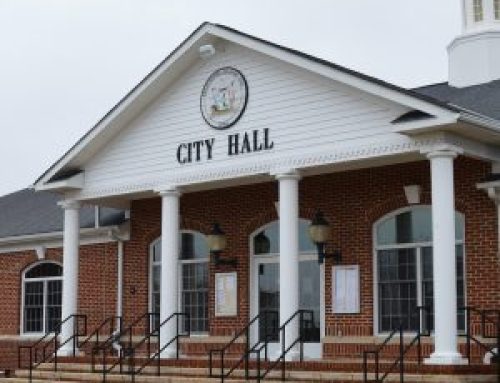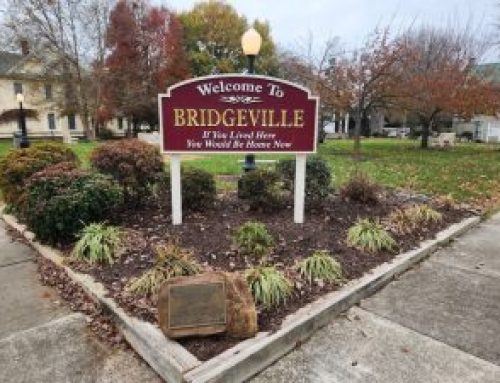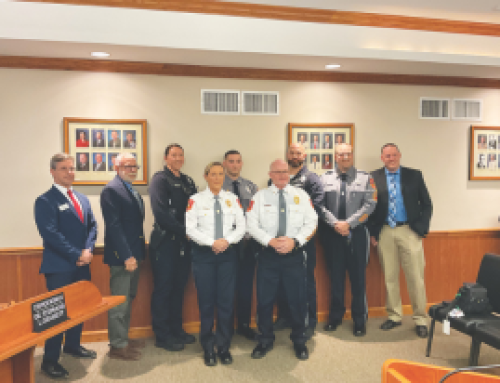The U.S. Environmental Protection Agency (EPA) held a public meeting on Thursday, July 20, at the fire hall in Blades to introduce its Proposed Remedial Action Plan and review alternative potential actions to protect homes from contaminated groundwater in residential wells. The plan, and the presentation, can be viewed online at www.epa.gov/superfund/BladesGroundwater.
After much testing, EPA estimates about 73 residences are affected or potentially affected within the area outside of the town of Blades to the south and southwest, bounded by Morgan Branch and the Nanticoke River. Several residences known to be affected have been provided with individual treatment systems. The town’s water system also has two huge carbon filters.

Remedial Project Manager Dan Taylor, right, introduced himself to residents before the EPA meeting July 20. Photo by Carol Kinsley
According to the EPA, the contamination “consists of heavy metals including cobalt, hexavalent chromium and lead and perfluoroalkyl/polyfluoroalkyl substances (PFAS) in groundwater.” There are two likely source areas of contamination located in the town of Blades: Procino Plating (now known as Procino Enterprises), an active metal plating facility, and the site of the former Peninsula Plating facility, which is currently vacant land.
The area was designated a Superfund Site and put on the National Priorities List in 2020. This “remedial action plan” is to prevent potential human exposure to contaminated groundwater used for drinking water, and is only step one. A final remedial action “which will comply with the Comprehensive Environmental Response, Compensation, and Liability Act (CERCLA) requirements to clean up contaminants in groundwater and restore the groundwater to beneficial use” may take decades.
Alan Geyer, remedial project manager, told the two dozen meeting attendees that EPA’s preferred alternative would be to offer all homes impacted or potentially impacted by the site-related contaminants of concern the opportunity to connect to a newly constructed public water line from the town’s water system. In addition, “institutional controls” would be put in place, such as local ordinances and/or groundwater management zones, to prevent the installation of new potable wells.
Capital costs, estimated at $5.7 million, would be funded by EPA, with monthly water use being paid by residents. Water bills typically run $35 per month.
This alternative is a permanent solution, Geyer said. It will provide reliable, treated water and is more cost-effective than other alternatives.
“We are not forcing this on anyone. We are encouraging,” Geyer said. “If you wish to be connected, your old well will be disconnected or converted to non-potable use — if risks related to the intended use allow.”
Those who do not wish to be connected would continue to use their private drinking wells. A stub would be provided for future connection, but all associated costs then would be at the homeowner’s expense.
Dan Taylor, also a remedial project manager, said EPA would look at each parcel, including any vacant lots, to determine whether provision should be made for later hook-up, again at homeowner expense.
In-home treatment systems that have been provided by the EPA would be maintained by EPA only until implementation of the alternative.
Other alternatives considered, all of which would be funded by EPA, were the following:
Alternative 1: Take no action. EPA is required to include this alternative as a baseline.
Alternative 2: Deliver bottled water to all impacted or potentially impacted residences until a future groundwater remediation project achieves cleanup goals. Typically, that might take up to 30 years. Estimated cost is $4.1 million.
Alternative 3: Install POETS/POUTS. POETS filter and treat all water entering the household. POUTS treat only the water intended for direct consumption (drinking and cooking) and are typically installed at a single tap or limited number of taps. This alternative would be in effect until total remediation is complete, typically up to 30 years. Estimated cost is $6.2 million.
Alternative 4: Install deeper, individual water wells into the Choptank aquifer, which is below the contaminant plume. These wells would be monitored until clean up is complete. Cost is estimated at $9.5 million.
Geyer noted that penetrating the clay layer above the Choptank aquifer with that many wells might increase chances of contamination farther below. The wells might need to be encased in steel, adding to the cost.
In the question and answer period that followed, the topic of annexation came up. Extending town water to these residences is needed because of danger, Geyer said. Annexation into the town is a separate matter.
Regarding a time frame, Geyer said completion of the preferred alternative might take two or three years. “Design is the biggest time component,” he added.
Asked why Procino is still in business, Taylor replied that all violations had been corrected. EPA’s goal is the protection of human health and the environment, and currently no contamination is happening. EPA has installed 47 monitoring wells, including 12 on Procino property.
Comments are encouraged and may be sent by email to ge********@*pa.gov, by mail to U.S. EPA Region 3, Attn: Alan Geyer, 1600 JFK Blvd., (Mail code: 3SD23), Philadelphia, PA 19103 or offered by phone at 215-814-3312. Deadline is Friday, July 28.
The preferred alternative as of now is only a recommendation, Taylor explained. A “Record of Decision,” outlining EPA’s choice, is expected to be complete sometime this winter.





